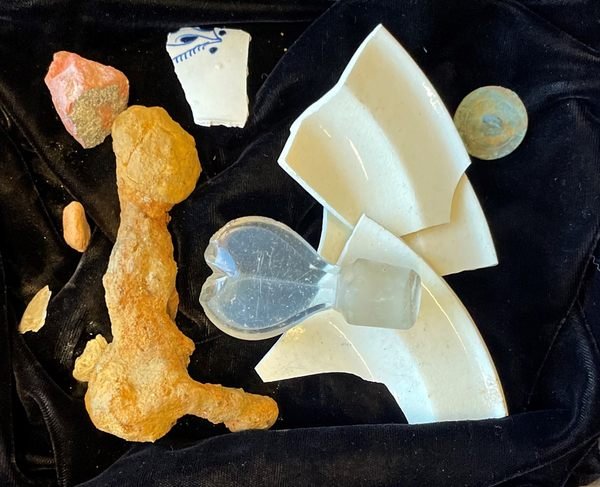Beneath an Old Fireplace, Evidence of the Spirituality of the Enslaved
The finds are also enriching understanding of the formative years of famed abolitionist Harriet Tubman.
BY LINE SIDONIE TALLA MAFOTSING
MARCH 21, 2023

Together these artifacts formed a spiritual bundle to protect a home from bad spirits and negative energy. TERI WINSLOW/MDOT/FLICKR
IN HER 1931 DOCUMENTATION OF African-American spiritual practices, author and anthropologist Zora Neale Hurtson wrote about Hoodoo, a set of traditions created by enslaved Africans in North America, with roots in indigenous West African religion. These practices were fundamental to the way the enslaved people defined their relationship to the world, to life, to death, and to each other. In the late 1980s, archaeologists began to make connections between these traditions and some of the material evidence they were uncovering at former plantation sites. From the discovery of crystals and other objects during 1986 and 1991 excavations at the Mont Clare Mansion in Baltimore, to the bundle of objects unearthed beneath a street in Annapolis in 2008, these artifacts can paint a clearer, more nuanced picture of the lives of enslaved people.
Recently, Maryland, the site of those other finds, has continued to produce such historical insights. In August 2022, a team of archaeologists led by Julie Schablitsky, chief of cultural resources at the Maryland Department of Transportation, discovered another spiritual cache at the Thompson Farm, the birthplace of abolitionist Harriet Tubman, in Dorchester County. This latest discovery, along with the foundations of a home, provide a window into the complex spiritual lives of the 40 or so people enslaved at Anthony Thompson’s plantation, and a new perspective on where the famed Underground Railroad activist was raised.
Since fall 2020, Schablitsky and her team have been excavating public and private property that was once part of the farm. Their first discovery was the home of Ben Ross, Tubman’s father. On the land that is now part of the Blackwater National Wildlife Refuge, they also found artifacts dating back to the 1800s, including nails, bricks, and dish fragments.
Then Schablitsky started thinking about the other individuals enslaved by Thompson on his 1,000-acre farm. “We began to look across the entire area, including on private lands,” she says. Two years into their excavation efforts, they discovered foundations of a brick home containing hundreds of artifacts dating between 1800 and 1840. Among them was a curious assemblage that had been buried under what would have been a fireplace: an unexpected glass trinket, ceramics, pieces of metal, in a place that they must have been placed deliberately.
More:
https://www.atlasobscura.com/articles/spiritual-artifacts-harriet-tubman-birthplace
